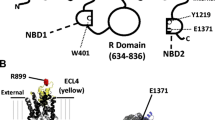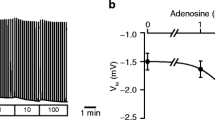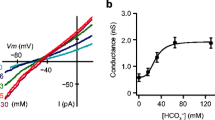Abstract.
Cystic fibrosis transmembrane conductance regulator (CFTR) is a channel and regulator protein that is crucially involved in transepithelial ion transport. In the exocrine pancreas, the CFTR-mediated secretion of an electrolyte-rich fluid is a major but as yet incompletely understood function. We show here that the peptide guanylin is a specific activator of CFTR function in the human pancreas implicating regulation of pancreatic electrolyte secretion. Guanylin and its affiliated signaling and effector proteins including guanylate cyclase C, cGMP-dependent protein kinase II, CFTR, and the epithelial \(Cl^-/HCO_3^-\) exchanger, anion exchanger 2, are highly expressed in the human pancreas. Guanylin is localized specifically to the typical centroacinar cells and proximal duct cells which, based on its additional presence in the pancreatic juice, is obviously released luminally into the pancreatic ducts. The guanylin receptor and the respective functional downstream proteins are all confined to the apical membrane of the duct cells implicating an as yet unknown route of luminal regulatory pathway of electrolyte secretion in the ductal system. Functional studies in two different human pancreatic duct cell lines expressing the CFTR Cl– channel that is functionally intact in CAPAN-1 cells but defective (ΔF508) in CFPAC-1 cells clearly identify guanylin as a specific regulator of pancreatic CFTR channel function. Whole-cell patch-clamp recordings in CAPAN-1 cells revealed that forskolin induces an increase of Cl– conductance mediated by cAMP. In contrast, guanylin increased Cl– conductance in the same cells via cGMP but not cAMP; the respective membrane current was largely blockable by the sulfonylurea glibenclamide. In CFPAC-1 cells, however, neither guanylin nor forskolin produced a current activation. Based on the present findings we conclude that guanylin is an intrinsic pancreatic regulator of Cl– current activation in pancreatic duct cells via cGMP and CFTR. Remarkably, in the pancreas guanylin may exert its function through an intriguing luminocrine mode via the pancreatic juice.
Similar content being viewed by others
Author information
Authors and Affiliations
Additional information
Electronic Publication
Rights and permissions
About this article
Cite this article
Kulaksiz, H., Schmid, A., Hönscheid, M. et al. Guanylin in the human pancreas: a novel luminocrine regulatory pathway of electrolyte secretion via cGMP and CFTR in the ductal system. Histochem Cell Biol 115, 131–145 (2001). https://doi.org/10.1007/s004180000244
Accepted:
Issue Date:
DOI: https://doi.org/10.1007/s004180000244




